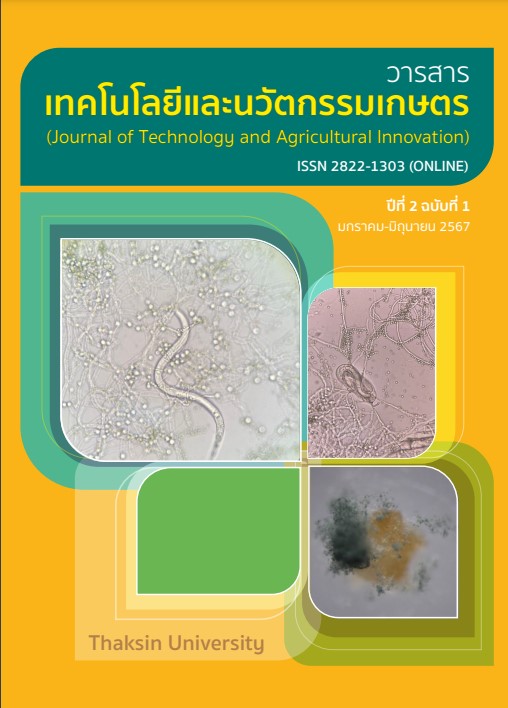Influence of Dietary Fiber Supplement From Mango Peel on The Characteristics of Yogurt
DOI:
https://doi.org/10.55164/jtai.v2i1.540Keywords:
Mango peel, Dietary fiber powder, YogurtAbstract
The aim of this study was to evaluated effect of dietary fiber supplement made from mango peel on the characters of yoghurt products. The fiber extraction was extracted from two mangocultivars as Mahachanok and Mansriwichai (raw and ripe). The result revealed the total of extracted fiber from raw mango peel of Mansriwichai cultivar was the significantly highest yield (P≤0.05).
Furthermore, the total extracted fiber, soluble and insoluble fiber from raw mango peel of Mansriwichai
cultivar were higher than the fiber from Mahachanok cultivar. Then, the fibers ground into powder
and sifted through two sizes of sieves, the small powder particles exhibited higher lightness value (L*)
and higher oil holding capacity compared to the large powder particles. Therefore, the dietary fiber
extracted from Mansriwichai cultivar was selected to add in tested yoghurt products, using four different
concentrations as 0%, 1%, 2% and 3% (w/w). The results were showed the yoghurt products with
added dietary fibers had significantly lower lightness value (L*) (P≤0.05). The treatment of added at
least 1 % of dietary fiber in yoghurt product had as many twice amount of Lactobacillus spp. (4.40 x107 CFU/ml) as the 0% dietary fiber in yoghurt product. In addition, the nutrition value of yoghurt product adding dietary fiber were significant increase as more than 1.20% of total fiber, 3.63% of protein content and 14.64% of carbohydrate. However, the lipid and moisture contents of yoghurt products adding dietary fiber were significant decrease as less than 3.64% of lipid and 76.30% of moisture.
References
ธัญนันท์ ฤทธิ์มณี. (2560). การสกัดและการใช้ประโยชน์จากหยวกกล้วยหอมทองเพื่อเสริมใยอาหารในไส้อั่ว.
รายงาน วิจัย ฉบับสมบูรณ์ คณะวิทยาศาสตร์และเทคโนโลยี มหาวิทยาลัยราชภัฏเชียงใหม่. สำนักงาน
คณะกรรมการวิจัยแห่งชาติ (วช.)
ปิยนุสร์ น้อยด้วง และปัทมา คล้ายจันทร์. (2548). การผลิตโยเกิร์ตกล้วยหอม. วารสารเทคโนโลยีการอาหาร
มหาวิทยาลัยสยาม. 1(1), 24–30.
นิธิยา รัตนาปนนท์. (2549). เคมีอาหาร. กรุงเทพฯ. สำนักพิมพ์โอเดียนสโตร์.
มนฤทัย ศรีทองเกิด กัณณิกา ทิพประมวล และปวีณา ชานาญยงค์. (2557). การใช้ประโยชน์จากผงเปลือกมะม่วง
เพื่อเป็นแหล่งของสารต้านอนุมูลอิสระและใยอาหารในผลิตภัณฑ์บะหมี่และแผ่นเกี๊ยว. รายงานการวิจัย
ฉบับสมบูรณ์. มหาวิทยาลัยราชภัฏสวนดุสิต.
วัลลี ภาคพจน์. (2562). องค์ประกอบทางเคมีของเปลือกมะม่วงน้ำดอกไม้เบอร์ 4 และการพัฒนาเป็นผลิตภัณฑ์ บราวนี่.
วิทยานิพนธ์ระดับปริญญาโท วิทยาศาสตรมหาบัณฑิต มหาวิทยาลัยเทคโนโลยีราชมงคลธัญบุรี
หยาดฝน ทนงการกิจ. (2557). การใช้ประโยชน์จากเศษผักผลไม้เหลือทิ้งเพื่อผลิตเป็นใยอาหารผง. วารสารเทคโนโลยี
การอาหาร มหาวิทยาลัยสยาม. 9(1), 31–38.
อรพรรณ นาสะอาด สุชาดา ไชยสวัสดิ์ และ ภานุ พลายบัว. (2558). การพัฒนากระบวนการสกัดใยอาหาร จากมะม่วง
ระดับต้นแบบเพื่อใช้ประโยชน์ในด้านอาหารเสริมสุขภาพ. รายงานวิจัยฉบับสมบูรณ์. มหาวิทยาลัยเทคโนโลยี
พระจอมเกล้าธนบุรี.
Ajila, C. M., Bhat, S. G., & Rao, U. J. S. (2007). Valuable components of raw and ripe peels from two
Indian mango varieties. Food Chemistry. 102, 1006-1011.
Ana, P.E.S., Nathalie, S.C., Thaiane, F. S., Fabiana, A.S.M. S., Luiz, A. G., Patrizia, P., Attilio, C. & Maricê, N. O.
(2012). Fibers from fruit by-products enhance probiotic viability and fatty acid profile and
increase CLA content in yoghurts. International Journal of Food Microbiology. 154, 135–144
A.O.A.C. (2016). Official Methods of Analysis of the Association of Official Analysis Chemistry. 20th ed.
AOAC INTERNATIONAL, USA.
A.O.A.C. (2019). Official Methods of Analysis of the Association of Official Analysis Chemistry. 21st ed. AOAC
INTERNATIONAL, USA.B.N.P. Sah, T. Vasiljevic, S. McKechnie & O.N. Donkor. (2016). Physicochemical,
textural and rheological properties of probiotic yogurt fortified with fibre-rich pineapple peel
powder during refrigerated storage. LWT - Food Science and Technology. 65, 978-986.
Bongkochrat Naowakul, Tri Indrarini Wirjantoro and Aphirak Phianmongkhol. (2013). Effects of speed
and time of wet milling on properties of dietary fiber powder from pomelo’s albedo. Food
and Applied Bioscience Journal. 1(1), 34-48.
Cadden, A.M. (1987). Comparative effect of particle size reduction on physical structure and water
binding properties of several plant fibers. Journal of Food Science. 52(6): 1595-1599.
COMP. (2015). Compendium of Methods for the Microbiological Examination of Foods (APHA), 5th
Edition, Chapter 19.
E. Sandra, V. Kuri, J. Ferna´ndez-Lo´ pez, E. Sayas-Barbera´, C. Navarro a, & J.A. Pe´rez-Alvarez. (2010).
Viscoelastic properties of orange fiber enriched yogurt as a function of fiber dose size and
thermal treatment. LWT - Food Science and Technology. 43, 708-714.
Figuerola, F., Hurtado, M. L., Estevez, A. M., Chiffelle, l. & Asenjo, F. (2005). Fibreconcentrates from
apple pomace and citrus peel as potential fibre sources for food enrichment. Food Chemistry.
, 395-401
B.N.P. Sah, W., Kordowska-Wiater, M., & Kozioł, J. (2011). The influence of selected prebiotics on the
growth of lactic acid bacteria for bio-yoghurt production. Acta Scientiarum Polonorum
Technologia Alimentaria. 10(4), 455-466.
Downloads
Published
How to Cite
Issue
Section
License
Copyright (c) 2024 Thaksin University

This work is licensed under a Creative Commons Attribution-NonCommercial-NoDerivatives 4.0 International License.


